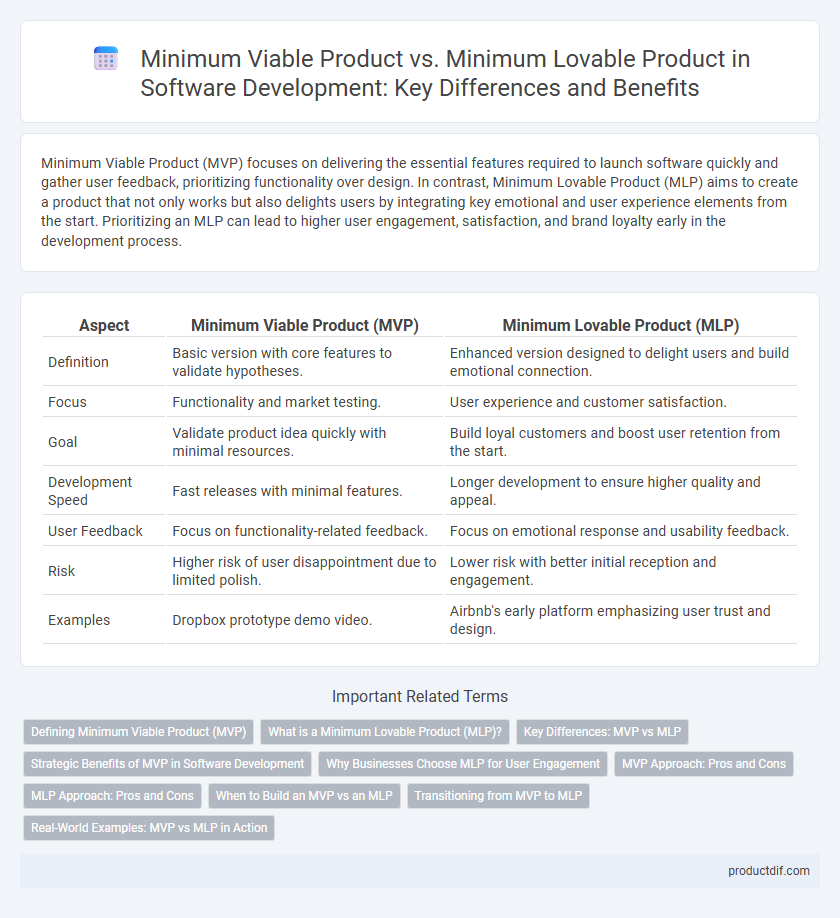Minimum Viable Product (MVP) focuses on delivering the essential features required to launch software quickly and gather user feedback, prioritizing functionality over design. In contrast, Minimum Lovable Product (MLP) aims to create a product that not only works but also delights users by integrating key emotional and user experience elements from the start. Prioritizing an MLP can lead to higher user engagement, satisfaction, and brand loyalty early in the development process.
Table of Comparison
| Aspect | Minimum Viable Product (MVP) | Minimum Lovable Product (MLP) |
|---|---|---|
| Definition | Basic version with core features to validate hypotheses. | Enhanced version designed to delight users and build emotional connection. |
| Focus | Functionality and market testing. | User experience and customer satisfaction. |
| Goal | Validate product idea quickly with minimal resources. | Build loyal customers and boost user retention from the start. |
| Development Speed | Fast releases with minimal features. | Longer development to ensure higher quality and appeal. |
| User Feedback | Focus on functionality-related feedback. | Focus on emotional response and usability feedback. |
| Risk | Higher risk of user disappointment due to limited polish. | Lower risk with better initial reception and engagement. |
| Examples | Dropbox prototype demo video. | Airbnb's early platform emphasizing user trust and design. |
Defining Minimum Viable Product (MVP)
Minimum Viable Product (MVP) refers to the most basic version of a software product that includes only essential features necessary to satisfy early adopters and validate core hypotheses with minimal development effort. Its primary goal is to quickly release a functional product to gather user feedback and iterate based on real-world usage. MVPs prioritize speed and efficiency over complete user experience, ensuring that the product can evolve through continuous testing and improvement.
What is a Minimum Lovable Product (MLP)?
A Minimum Lovable Product (MLP) is a development approach that focuses on delivering a product with the smallest feature set that customers not only use but genuinely love, creating strong emotional engagement. Unlike a Minimum Viable Product (MVP), which aims to test basic functionality, the MLP prioritizes user experience, design, and value, ensuring early adopters become enthusiastic advocates. This strategy helps startups build brand loyalty and accelerate growth by addressing customer needs and emotions from the outset.
Key Differences: MVP vs MLP
Minimum Viable Product (MVP) focuses on delivering core functionalities with just enough features to satisfy early adopters and validate product assumptions, emphasizing speed and efficiency in development. Minimum Lovable Product (MLP) prioritizes user experience and emotional connection by including features that delight users and foster brand loyalty, aiming to build a passionate customer base from the start. Key differences lie in MVP's emphasis on functional validation versus MLP's focus on creating a product that users love and eagerly recommend.
Strategic Benefits of MVP in Software Development
Minimum Viable Product (MVP) enables rapid market entry by delivering core functionalities that validate product concepts with minimal resource investment. This strategic approach reduces development risks and gathers essential user feedback early, allowing iterative improvements that align with market demands. Leveraging MVP accelerates time-to-market and optimizes resource allocation, driving informed decision-making in software development cycles.
Why Businesses Choose MLP for User Engagement
Businesses choose Minimum Lovable Product (MLP) over Minimum Viable Product (MVP) to enhance user engagement by delivering features that resonate emotionally and provide immediate value. MLP emphasizes user delight and satisfaction, which drives higher retention and encourages positive word-of-mouth, essential for sustainable growth. Prioritizing compelling user experiences in the product development process helps companies build stronger brand loyalty and accelerate market adoption.
MVP Approach: Pros and Cons
The Minimum Viable Product (MVP) approach accelerates time-to-market by focusing on core features, enabling rapid user feedback and iterative development; however, it risks releasing a product that may feel incomplete or lack emotional engagement. In contrast, prioritizing only minimal features might overlook user delight, potentially reducing early adoption rates and limiting brand loyalty. Balancing quick validation with an engaging user experience is crucial for sustainable software success.
MLP Approach: Pros and Cons
The Minimum Lovable Product (MLP) approach emphasizes creating software with features that users find valuable and engaging, fostering early emotional connection and increased retention compared to the Minimum Viable Product (MVP), which focuses on basic functionality to validate a concept quickly. Pros of the MLP include higher user satisfaction and stronger brand loyalty, while cons involve longer development times and increased initial costs. Choosing between MVP and MLP depends on project goals, target audience, and the balance between speed to market and user experience quality.
When to Build an MVP vs an MLP
Building a Minimum Viable Product (MVP) is ideal during early-stage product development to validate core functionalities with minimal investment and gather user feedback quickly. A Minimum Lovable Product (MLP) should be prioritized when there is a need to create emotional connections and ensure user retention by delivering a delightful experience from the outset. Choosing between MVP and MLP depends on market maturity, user expectations, and the strategic balance between speed to market and product quality.
Transitioning from MVP to MLP
Transitioning from Minimum Viable Product (MVP) to Minimum Lovable Product (MLP) involves enhancing core features with exceptional user experience and emotional engagement. Emphasizing usability, design refinement, and customer feedback transforms a functional MVP into an MLP that drives higher user retention and satisfaction. Prioritizing these elements accelerates market adoption and builds brand loyalty beyond basic viability.
Real-World Examples: MVP vs MLP in Action
The Minimum Viable Product (MVP) for Instagram launched in 2010 with basic photo-sharing features, quickly attracting users through essential functionality and rapid iteration. In contrast, Airbnb's early Minimum Lovable Product (MLP) emphasized a seamless user experience and trust-building elements, such as detailed host profiles and reviews, fostering emotional engagement from the start. These real-world examples highlight how MVPs focus on validating core functionality, while MLPs prioritize user delight and long-term retention.
Minimum Viable Product vs Minimum Lovable Product Infographic

 productdif.com
productdif.com